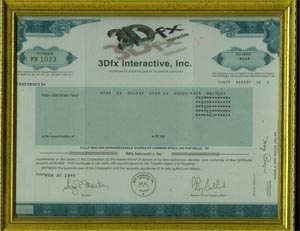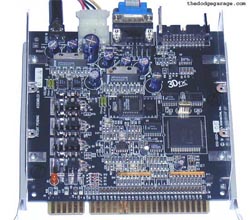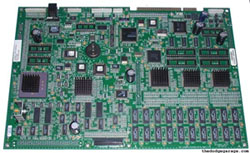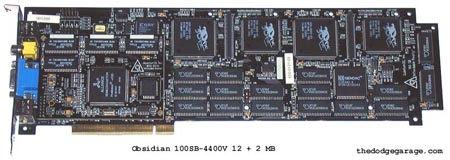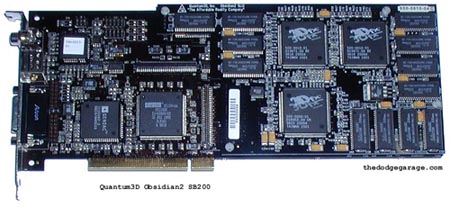
| Summary: |

History of 3DFX : 1994-1998
| 1994 |
Towards the end of the year 1994 four people put the foundation-stone to a company, which should change the world of computer graphics forever. Gordon Campell, as the initiator, Gary Tarolli as chief developer, Scott Sellers as chief engineer and Ross Smith as marketing leader built up the company 3Dfx Incorporates.
 G. Campbell |
 G. Tarolli |
 S. Sellers |
| 1995 |
On 27 March in the next year, 3Dfx Interactive was brought into being by a seed capital of 5,5 million USD.
In the time of its establishment 3Dfx Interactive was willing to develop graphics and interface systems for Arcade gaming machines, since they were still clearly superior to commercial computers which served as game platforms at this time. Nevertheless 3Dfx Interactive already attached importance to build products which use PC-compatible interfaces like the PCI bus and they also built interface modules for connecting console input devices with computer interfaces.
One of the first well-known modules was the JAMMA Game-Control-Interface GCI. It translates signals of the control sticks and keys of a play hall console by a Microcontroller of Intel (type 80C51) into a RS232 compatible signal for a PC.
As in the later process of the history of 3Dfx will show up, it is exactly this segment of computer hardware which is still today carried on by another company as a basic idea of 3Dfx … creating virtual worlds at the computer to entertain people, who are using it. As already mentioned before, in the middle of the 90's the play hall consoles were still far superior to the computers in displaying virtual worlds. There were graphics cards which possessed a certain self-intelligence, however, these were still not able to compute three-dimensional objects to compute or representing it without assistance of the main processor in the computer.
Some companies such as S3 with the Virge chip or NEC with the PowerVR had already tried to develop such "3D-Chips" , so far these experiments weren’t affected by success, yet. In this market 3Dfx saw its chances and already presented on 6 November 1995 a truebred "3D-accelerator" for the first time to the COMDEX, as well as for the computer and for Arcade systems: The Voodoo Graphics accelerator and consequently the beginning of the 3D-computergame-era.
However, 3Dfx only supplied the graphics chip set consisting of a texture and a pixel unit to third manufacturers, as well as a recommended reference layout. The graphics cards were then built and distributed through third companies.It was specially at this time that these graphics cards were not able to represent a normal computer screen. They only worked together with compatible games, thus the graphics cards were pure auxiliary products to existing computer systems.
Even at the same day the COMDEX took place the first Voodoo graphics cards for computers were announced by the company Orchid. They delivered a mass of graphic cards briefly on it to the market besides other manufacturers. The game-industry showed up highly pleased by the new technology and announced a mass of products which will support the 3Dfx products. Still in the same year on 27 November 3Dfx closed a contract for co-operation with Alliance Semiconductor at technical new developments. This had effects even to later products of 3Dfx like the upcoming Voodoo Rush cards, for example.

| 1996 |
On 4 March 1996, just under one year after the establishment, 3Dfx received a further capital inflow of 11.6 million USD. Still in the same month the co-operation with Micronics Computers was sealed, these should develop a platform for play hall consoles based on the Voodoo Graphics system in connection with that already admitted company Orchid. Already on 16 May the first play hall automat based on this system could be delivered.
Nearly at the same time as the first Voodoo Graphics cards came at the beginning of August 1996 on the market, 3Dfx already announced a kind of a successor: The Voodoo Rush. The internal 2D interface of the Voodoo Graphics should be used together with a well-known 2D chip (predominantly Alliance Semiconductor chips came to the use) to offer a adequate graphics card in one product. On the day exactly mentioned, the first Voodoo Graphics (Voodoo 1) graphics cards appeared in the dealer shelves on 5 August: The Diamond Monster 3D.
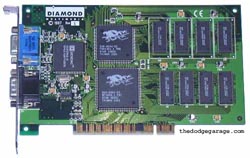 Diamond Monster 3D |
The potential of the 3Dfx technology was already made clear with the first tests: A Pentium 200 MMX at that time did not bring in Quake 1 with a resolution of 320x200 with 41 frames per second what was needed for the future in three-dimensional games. Using the new 3Dfx technology increased the performance already to 70 frames per second. In higher resolutions the boosted output amounted to partly impressing 300%!
Together with the Voodoo 1 3Dfx delivered also its own software interface to their graphics cards: GLIDE. Consequently game developers were easily able to tap the full potential of therse graphics cards. Some play developers provided new updates for Voodoo cards to existing games. At the end of August the probably most well-known title for the Voodoo Graphics at all was published: Tomb Raider 1 with the game figure Lara Croft. Soon legendary titles appeared such as POD, Mechwarrior 2 and many further, which used the technology of 3Dfx, the break-through had finally succeeded!
On 18 November 1996 3Dfx showed again at the COMDEX its newest creation in co-operation with Hercules: The first Voodoo Rush graphics card with own 2D-kernel, at that time still as a graphics card with a "sandwich-design".
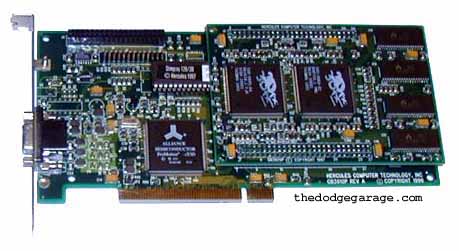
Towards the end of the year, on 9 December 3Dfx again received a capital syringe at a value of 11.6 million USD and seemed to be prepared for the coming years at best.
| 1997 |
In the beginning of the year 1997 3Dfx experienced a true high-altitude flight: Sega engaged the chip smithy for the new Dreamcast console, in addition the official 3Dfx extension appeared for the highly popular game Quake in the form of GLQuake.
 |
At 31 March 1997 Quantum 3D was incorporated as an independent company. Already at 8 April 3Dfx and Quantum 3D band together, when Q3D took over the product group Obsidian, in order to develop them further and adapt these based on the products of 3Dfx for the console and simulation market. |
In April the first Hercules Rush graphics cards appeared still in the "sandwich design" on the market. However, in June they were replaced successfully by a revised version with only one plate. At the same time further companies like Jazz Multimedia and Intergraph brought their own Rush graphics cards based on the reference design on the market.
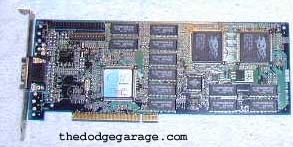
In spite of the spezial versions of Hercules with TV Out and a faster clock rate the Rush didn’t enjoy as much popularity as the Voodoo1 cards did. Therefore, the Rush was rather degenerated to an edge product.
In September 3Dfx suffered the first setback in their firm history: Sega cancelled the contract for the Dreamcast console. Although the law case was won in the year after by 3Dfx, it silted up without any further successes in this industry.
Nevertheless, the time did not stand still and in November 3Dfx announced the successor of the Voodoo 1: The Voodoo 2 chipset. At the same time with the announcement of the Voodoo 2 chipsets, partner Q3D communicated their first Voodoo 2 products. A further high-altitude flight announced itself by the interest of Creative Labs in Voodoo 2 products, Creative was indeed the the largest manufacturer of multimedia products for the computer sector at that time.

| 1998 |
On 20 January 1998 Creative, as the new partner of 3Dfx, announced their first Voodoo 2 graphics cards maps the first Voodoo and brought these briefly before the products of Diamond with the Monster 3D 2 on the market.
On 31 March Q3D opened its on-line Shop and offered in April their first Voodoo 2 products in large quantities under the name Obsidian 2. Before Quantum was the only company which had developed graphics cards, which combined several Voodoo 1 cards to a kind of combination (Quantum SB100-44x0) as a transition to the Voodoo 2 technology. 3Dfx called this technology SLI (Scan Line Interleave). This term should again have a lasting effect affect in the games sector during the times of the Voodoo 2…
The Voodoo 2 graphics cards made an impact into the computer game scene: It has never been possible to create so brilliant 3D worlds in such a short time – even though 3Dfx only strongly drilled out the best of the Voodoo 1. With a so called SLI-combination of two graphics cards it was the very first time possible to play computer games in resolutions of 1024 on 768 pixels. The downward compatibility to the Voodoo 1 and continuing of all well-known standards was well received by the developers.
New technologies like the Bump Mapping made the players’ mouth water.
June 1998 was the an absolute high point in the firm history of 3Dfx. For the first time a combined chip with 2D and 3D-kernel was announced, the Banshee. Although it became later on nearly the most unpopular product of 3Dfx, the company was very optimistic in the apron due to current success.
At the same time more and more Voodoo 2 based graphics cards among others of Canopus (Pure 3D) and Guillemot (Maxi Gamer) appeared on the market and introduced a new era of the computer gaming: The 3D-graphics cards became kind of standard for the players PC.
On 22 September 1998 it came to the first direct confrontation with the next competitor nVidia: 3Dfx filed an action because of a patent law injury in connection with the Multi Texturing technology. Due to counter suits this law should further-pull itself until the fall of 3Dfx.
In October then the first Banshee graphics cards were published. These should animate among other things the OEM market of the PC manufacturers, however this unfortunately never happened. The Banshee never became a beloved product. One reason might be, that it just disposed of parts of the power of the Voodoo 2 cards.
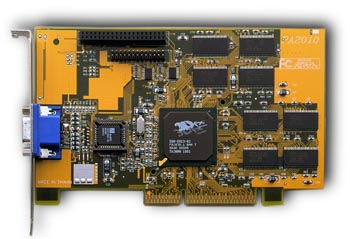
Voodoo Banshee
Also competitor nVidia rung in the 32-Bit ages with a huge Hype. For the first time 3Dfx became aware of their competitors, because of their graphics cards were just able to render 16-Bit.
In the middle of November the next generation of the 3Dfx chips was announced, at the same time the appearance and the internal structures of the company should get to feel a fresh wind: A new firm emblem and the Voodoo 3 chip Avenger were announced. On 14 December of the year 1998 3Dfx bought in the graphics cards assembler STB Systems in Mexico to be able to sell the whole graphics cards under their own name in the future. Only five months later the first card should reach the market.
The year 1998 was the most successful in the short firm history of 3Dfx: With the Voodoo 2 chip set both players as well as games developers were very contently. Consequently, products which were based on this technology stated in each month the salesman lists. The Banshee chipset couldn’t tie in directly with this success. However, OEM partnerships with Compaq, Packard Bell, Gateway and others resulted.
